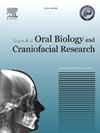Assessment of chewing and swallowing in post mandibular resection patients with no bony reconstruction – A cross sectional study
Q1 Medicine
Journal of oral biology and craniofacial research
Pub Date : 2025-01-01
DOI:10.1016/j.jobcr.2024.12.014
引用次数: 0
Abstract
Introduction
The intricate process of chewing and swallowing is compromised following mandibular resection. An evaluation of chewing and swallowing is crucial to comprehend the quality of life following surgery in cases when bone repair was not performed. The purpose of this study is to evaluate chewing and swallowing in mandibulectomy patients without bony reconstruction.
Material and method
This study involved ten patients, including four with H defects, three with L defects, and three with LC defects, after a one-year postop period. Using Robbin's penetration aspiration scale, video fluoroscopy was used to evaluate swallowing. Using a functional oral intake scale, chewing was assessed. Fischer's exact test was used for statistical analysis.
Results
Robbin's penetration aspiration scale score of 1 was noted in all 10 patients. According to FOIS, 50 % of patients with H defect scored 4, and 66.7 % of those with L defect scored 6. The results were not significant when the scores were correlated with the type of defect.
Conclusion
Mandibular surgical defects which were not reconstructed with bone were shown to affect the quality of life in our study. Chewing efficiency was poorest in patients with H defect. Swallowing efficiency was not affected adversely in this group of patients.

评估下颌切除术后无骨重建患者咀嚼和吞咽-一项横断面研究
下颌骨切除术后,复杂的咀嚼和吞咽过程受到损害。在没有进行骨修复的情况下,评估咀嚼和吞咽对了解手术后的生活质量至关重要。本研究的目的是评估无骨重建的下颌骨切除术患者的咀嚼和吞咽。材料与方法本研究共纳入10例患者,其中H型缺陷4例,L型缺陷3例,LC型缺陷3例,术后1年。采用robin(氏)穿刺吸痰量表,视频透视检查吞咽情况。使用功能性口腔摄入量表评估咀嚼情况。采用Fischer精确检验进行统计分析。结果10例患者robin穿刺吸痰评分均为1分。根据FOIS, 50%的H缺陷患者得分为4分,66.7%的L缺陷患者得分为6分。当分数与缺陷类型相关时,结果不显着。结论下颌骨手术缺损不以骨重建影响患者的生活质量。H型缺损患者咀嚼效率最差。该组患者的吞咽效率未受不良影响。
本文章由计算机程序翻译,如有差异,请以英文原文为准。
求助全文
约1分钟内获得全文
求助全文
来源期刊

Journal of oral biology and craniofacial research
Medicine-Otorhinolaryngology
CiteScore
4.90
自引率
0.00%
发文量
133
审稿时长
167 days
期刊介绍:
Journal of Oral Biology and Craniofacial Research (JOBCR)is the official journal of the Craniofacial Research Foundation (CRF). The journal aims to provide a common platform for both clinical and translational research and to promote interdisciplinary sciences in craniofacial region. JOBCR publishes content that includes diseases, injuries and defects in the head, neck, face, jaws and the hard and soft tissues of the mouth and jaws and face region; diagnosis and medical management of diseases specific to the orofacial tissues and of oral manifestations of systemic diseases; studies on identifying populations at risk of oral disease or in need of specific care, and comparing regional, environmental, social, and access similarities and differences in dental care between populations; diseases of the mouth and related structures like salivary glands, temporomandibular joints, facial muscles and perioral skin; biomedical engineering, tissue engineering and stem cells. The journal publishes reviews, commentaries, peer-reviewed original research articles, short communication, and case reports.
 求助内容:
求助内容: 应助结果提醒方式:
应助结果提醒方式:


